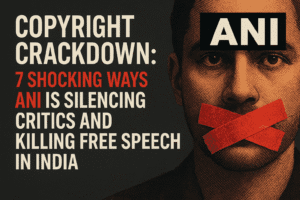Copyright Crackdown: 7 Shocking Ways ANI is Silencing Critics and Killing Free Speech in India
A media giant’s aggressive copyright tactics are exposing cracks in India’s digital free speech ecosystem. Asian News International (ANI), a legacy news agency, has weaponized YouTube’s “three-strikes” policy to pressure political commentators—many critical of the BJP—into paying exorbitant licensing fees (up to ₹40 lakh) or risk losing their channels permanently. While India’s copyright law permits “fair dealing” for critique or news analysis, vague definitions and YouTube’s liability-averse takedown system empower entities like ANI to exploit legal gray zones.
Creators, fearing years of work erased overnight, face an impossible choice: pay up or vanish. Journalist Ravish Kumar warns this disproportionately punishes creators, equating unproven claims to “defamation suits of ₹100 crore.” With ANI’s litigious history and BJP-aligned coverage, critics allege this stifles dissent, as independent creators fill gaps left by muted mainstream media. The clash underscores urgent needs: clearer fair-use guidelines, platform accountability, and protections for India’s burgeoning digital democracy—before backroom deals between corporations dictate who controls the narrative.

Copyright Crackdown: 7 Shocking Ways ANI is Silencing Critics and Killing Free Speech in India
When Sumit* received seven days to save his YouTube channel from permanent deletion, it wasn’t just his livelihood at stake—it was a symptom of a systemic clash between India’s evolving digital media landscape and powerful legacy players. Asian News International (ANI), a 55-year-old media conglomerate, had filed multiple copyright strikes against his political commentary channel, which critiques the ruling BJP. To avoid losing years of work and a loyal audience, Sumit paid ANI a staggering ₹15–18 lakh to settle the claims. His story isn’t unique.
The Copyright Trap: From Creators to Cash Cows
ANI, a primary news source for Indian TV and digital outlets, has adopted an aggressive strategy: flooding YouTube creators with copyright strikes, then demanding hefty licensing fees (reportedly up to ₹40 lakh) to withdraw them. For creators like Sumit, this creates an impossible choice—pay up or lose their channel, income, and community overnight.
YouTube’s “three-strikes” policy amplifies this pressure. Even unproven claims can delete a channel in days, leaving creators with little recourse. While platforms like YouTube claim neutrality, their policies disproportionately favor established entities. As one creator lamented, “I knew ANI might strike me, but I never thought I’d be forced to pay lakhs just to survive.”
Fair Use or Fear? India’s Legal Gray Zone
India’s Copyright Act permits “fair dealing” for criticism, commentary, or news reporting. Yet vague definitions—like how much of a clip can be used—leave creators vulnerable. Unlike the U.S., where platforms like YouTube fund legal defenses, Indian creators face a rigged system:
- Legal Costs: Challenging strikes in court is expensive and slow.
- Power Imbalance: ANI’s litigious reputation (see lawsuits against OpenAI and Wikimedia) deters resistance.
- Platform Apathy: YouTube’s takedown-first approach protects its liability, not creators’ rights.
Ravish Kumar, a journalist with 13 million YouTube subscribers, warns: “Shutting a channel over mere claims—not proven violations—is unjust. Penalties should match the offense, not erase livelihoods.”
The Bigger Picture: Silencing Dissent and Shaping Narratives
ANI’s tactics coincide with a surge in political commentary channels critiquing the BJP, especially during the 2024 elections. These creators fill a void left by mainstream media’s muted criticism, attracting millions with analysis spliced with news clips. But ANI’s dual role as a BJP-aligned news provider and copyright enforcer raises concerns about censorship.
As one YouTuber noted, “During elections, my revenue skyrocketed. Now, ANI’s strikes feel like a targeted tax on dissent.” Internal emails reviewed by The Collective reveal ANI’s managing director’s family members involved in negotiations, hinting at a centralized strategy.
Why YouTube’s “Balance” Fails Indian Creators
YouTube claims to balance copyright holders’ rights with creator freedom but applies U.S.-centric policies (like the Digital Millennium Copyright Act) unevenly. In India, intermediaries face weaker legal protections, pushing platforms to prioritize avoiding lawsuits over protecting speech.
Nikhil Narendran, a media lawyer, explains: “Indian law prioritizes private copyright claims over public free speech. Platforms like YouTube adjust accordingly, leaving creators exposed.”
The Road Ahead: A Fight for Digital Democracy
This conflict underscores urgent gaps:
- Legal Clarity: Clear “fair use” guidelines are needed to prevent abuse.
- Platform Accountability: YouTube must reform strike systems to avoid arm-twisting.
- Collective Action: Creators, lawmakers, and civil society must push for reforms.
As ANI and YouTube’s backroom deals set dangerous precedents, the stakes extend beyond individual channels. Without change, India risks silencing critical voices in its most democratic space—the internet.
You must be logged in to post a comment.